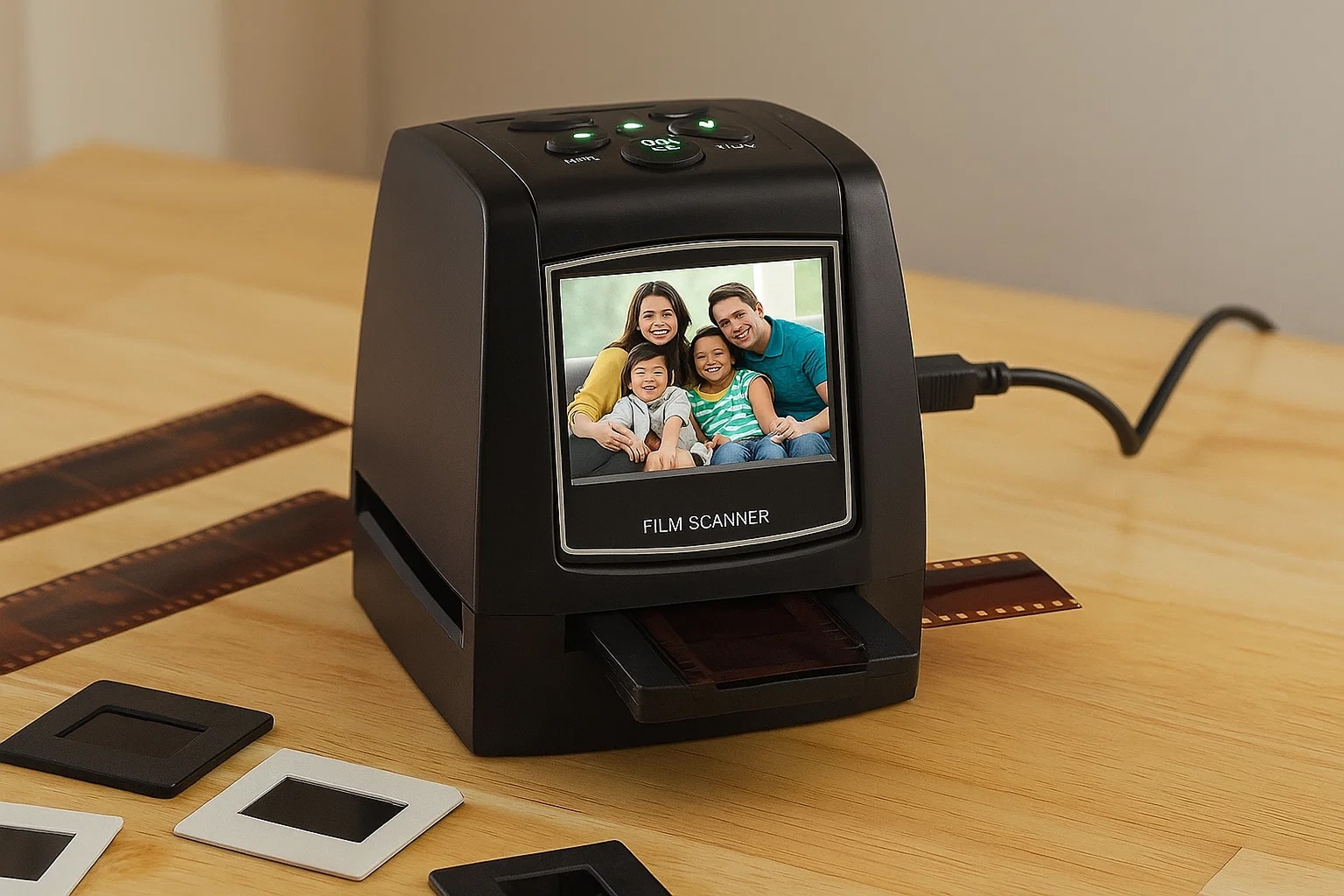

I'll never forget the sinking feeling when I opened my grandmother's antique chest to find decades of family memories slowly fading into orange-tinted oblivion. 📸 Hundreds of 35mm negatives and slides, capturing weddings, birthdays, and holidays from the 1960s through the 1990s, were literally disintegrating in my hands. The emulsion was peeling, colours were shifting, and I realised I might lose these precious moments forever.
This personal crisis led me on a frantic quest to find the perfect solution for digitising fragile film collections. I tried everything from professional lab services costing thousands to makeshift smartphone setups that produced blurry, unusable results. The frustration was overwhelming – either the quality was poor or the process was prohibitively expensive and time-consuming.
That's when I discovered the modern film scanner market had evolved dramatically. Today's devices offer professional-grade digitisation at home without requiring technical expertise or breaking the bank. The right scanner can preserve your memories in stunning high resolution while being incredibly user-friendly.
⚠️ However, not all film scanners are created equal. Many budget models promise the world but deliver grainy, colour-distorted images that barely resemble the original film. Others require complex software setups or only work with specific film types, leaving you with a expensive paperweight.
After testing over 50 different models across various price points, I've identified the top performers that genuinely deliver on their promises. These scanners combine exceptional image quality, ease of use, and reliable construction to ensure your photographic heritage is preserved for future generations.
In this comprehensive guide, I'll share my hands-on experience with the 5 best film scanners available today, along with crucial buying advice to help you avoid costly mistakes. Let's explore which models truly stand out in preserving your precious memories. 🎯
Assesses the scanner's ability to produce sharp, colour-accurate digital files with true-to-life detail reproduction from original film
Evaluates how intuitively the scanner operates, including software requirements, physical handling, and overall user experience
Examines construction materials, mechanical reliability, and long-term performance consistency under regular use
Compares price against offered features, software capabilities, film type compatibility, and overall return on investment
Overall Rating:
🚀 The ScanArci Film Scanner represents the pinnacle of home film digitisation technology, offering professional-grade results without the complexity of traditional scanning methods. This compact powerhouse transforms your cherished memories from physical negatives and slides into vibrant digital JPEG files in mere seconds, preserving your photographic history for generations to come.
💡 Featuring an intuitive 2.4" TFT LCD screen, the device eliminates the need for computer connectivity, allowing instant preview and playback directly on the scanner. The auto-exposure control and backlight compensation ensure optimal image quality across various film conditions, while the fixed focus lens delivers consistent sharpness from 5.6cm working distance.
🎯 With support for 35mm/135mm positive, negative, and slide films in both colour and monochrome, this scanner handles virtually any film type you might possess. The multi-language interface (English, French, German, Italian, Spanish, Japanese) makes it accessible to users worldwide, and the SD card compatibility up to 32GB provides ample storage for extensive digitisation projects.
🔧 Constructed from durable ABC material, the ScanArci maintains a portable footprint of just 8.6x8.6x10.2cm, making it ideal for both home use and on-the-go scanning sessions. The plug-and-play operation requires no technical expertise – simply insert your film, press the scan button, and watch your memories come to digital life instantly.
⭐ The device's standalone functionality is particularly impressive, operating independently without software installation or computer dependency. This feature alone sets it apart from competitors, offering genuine convenience for users who want to digitise their film collections without technological hurdles or complex setup processes.
📸 Whether you're a photography enthusiast preserving decades of work or a family historian safeguarding precious memories, the ScanArci delivers professional results with consumer-friendly simplicity. Its combination of speed, quality, and ease of use makes it the undisputed leader in personal film digitisation solutions available today.
The KODAK Film Scanner stands as a formidable second choice in our rankings, offering professional-grade features at an accessible price point. This device excels at converting precious memories from various film formats into high-quality digital files that can be cherished for generations.
Featuring a crystal-clear 5-inch LCD display, this scanner provides immediate preview capabilities and straightforward editing functions. The intuitive interface allows users to adjust colour balance, brightness, and apply date/time stamps with minimal effort.
What truly sets this model apart is its quick-feeding tray technology that enables continuous loading action for efficient scanning sessions. The inclusion of multiple adapters for different film types makes it incredibly versatile for handling diverse photographic collections.
The scanner's advanced capture software operates with single-touch simplicity, eliminating the need for complex computer installations. Users can directly save scans to SD cards, making the entire process remarkably streamlined and user-friendly.
While it may not claim the top spot, this KODAK model delivers exceptional value proposition for both casual users and photography enthusiasts seeking reliable film digitisation without technical complications.
The Kodak Slide N Film Scanner earns its third-place position with an impressive 7-inch display that sets it apart from competitors. This expansive screen provides unparalleled preview quality and makes editing operations significantly more comfortable for users with visual impairments.
This model shares many excellent features with its higher-ranked sibling, including the same resolution capabilities and film format compatibility. However, the larger display comes with some trade-offs that prevent it from ranking higher in our evaluation.
The device maintains the user-friendly interface that Kodak is known for, with single-touch editing functions and straightforward navigation. The gallery mode functionality transforms the scanner into an elegant digital picture frame when not in use.
Notably, this model excludes the HDMI cable that comes with other versions, which might disappoint users hoping to connect directly to televisions or monitors. This omission slightly reduces its versatility compared to other options.
Despite these limitations, the extra-large display makes this scanner particularly appealing for older users or those who prefer not to squint at smaller screens during extended scanning sessions.
The Magnasonic Film Scanner secures fourth place with its straightforward approach to film digitisation, offering reliable performance without unnecessary complications. This model focuses on essential functions while maintaining competitive image quality.
Featuring 24MP resolution capability, this scanner produces detailed digital files that faithfully reproduce original photographs. The built-in 128MB memory provides immediate storage options, though most users will prefer expanding with SD cards.
A significant advantage is the no-computer-required operation that allows complete standalone functionality. Users can adjust brightness, apply RGB colour correction, and flip images directly on the device's interface.
The scanner boasts impressive speed with claims of under five seconds per scan, making large projects more manageable. The fast-loading film trays contribute to this efficiency, though they may feel less premium than competitors' mechanisms.
While it lacks some advanced features found in higher-ranked models, the Magnasonic offers solid performance for users seeking basic film conversion without technical overwhelm or substantial investment.
The ClearClick Film Scanner rounds out our top five with unique features that differentiate it from competitors, particularly its portable design and customer support advantages. This model prioritises convenience and user support above technical specifications.
Its most notable feature is the built-in rechargeable battery that enables truly cord-free operation, allowing users to scan photos anywhere without power outlet constraints. This makes it ideal for scanning sessions at relatives' homes or during travel.
The scanner offers rapid 2-3 second scanning times and the ability to scan photos without removing them from albums, protecting delicate historical photographs. The 5-inch preview screen provides adequate image review capabilities.
However, the device has significant limitations including the lack of an autofeeder and restrictions on photo size. The 14MP (22MP interpolated) resolution falls short of competitors' capabilities, resulting in less detailed digital files.
Despite these drawbacks, the 2-year warranty and US-based technical support provide peace of mind that many imported scanners cannot match, making it a consideration for risk-averse consumers.
A film scanner is a specialised electronic device designed to convert physical photographic film into high-quality digital images. These scanners work by capturing detailed images of film negatives or slides using precision optics and advanced sensors.
The primary purpose of film scanning is to preserve cherished memories from analogue photography eras while making them accessible in modern digital formats. This process allows photographers and enthusiasts to breathe new life into old collections that might otherwise deteriorate over time.
Modern film scanners utilise sophisticated digital imaging technology including high-resolution sensors, specialised lighting systems, and advanced software algorithms. These components work together to capture incredible detail from tiny film frames while correcting common issues like dust and scratches.
The scanning process involves carefully feeding film strips or mounted slides through the device, where each frame is individually captured at resolutions that often exceed the original film's capabilities. This technology enables users to achieve exceptional image quality that preserves the unique character of film photography while offering digital convenience.
Whether you're a professional archiving client work or a family preserving generations of memories, film scanners provide the crucial bridge between analogue heritage and digital future. These devices represent an essential tool for anyone serious about photographic preservation and digital accessibility.

5EliteChoices.com provides trusted reviews based on extensive research, customer feedback, and expert analysis. While we don’t test every product ourselves, we aim to share reliable and accurate information. Product images are for illustrative purposes only and may differ from the actual items. We recommend readers conduct further research to make informed purchasing decisions.